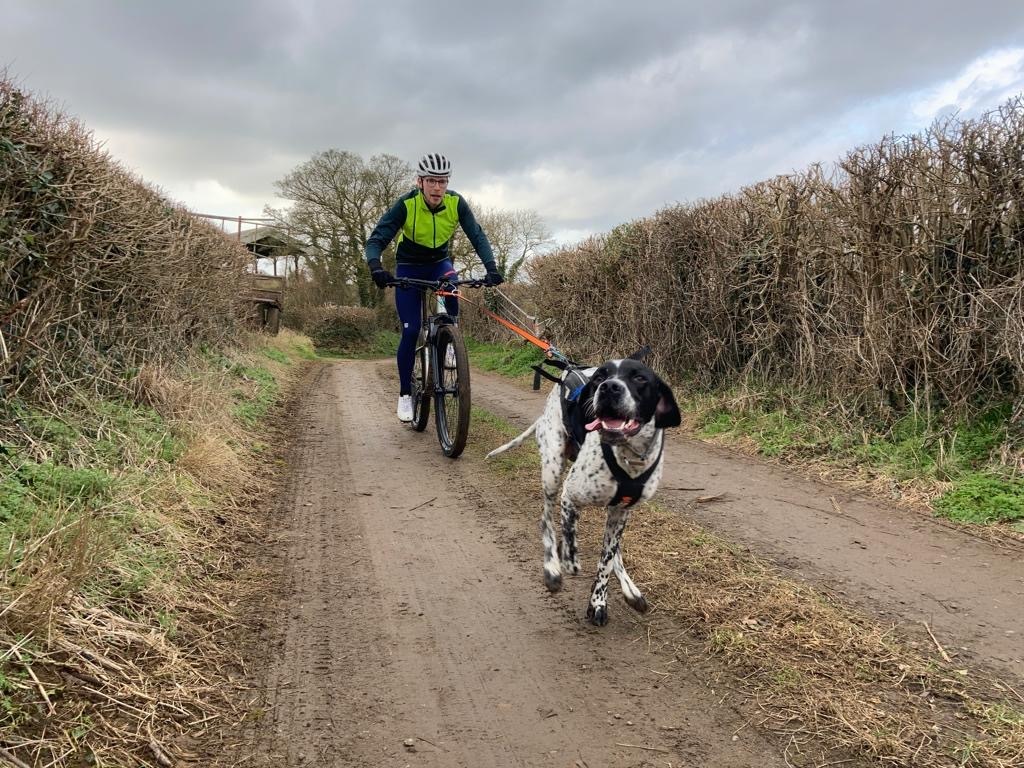Cyclingnews Verdict
For daylight riding these lights offer superb visibility, and for street light lit commutes are plenty bright enough. However for not much more money, you can get a significantly more powerful light set that offers more versatility.
Pros
- +
Impressive battery life on flash modes
- +
Very small and compact
- +
Lights pack a decent punch and aid daytime visibility well
- +
Ambient light sensor is clever tech in such a small light
Cons
- -
Mounting system is difficult on non-round bars and seatposts
- -
Micro USB charging rather than USB-C
- -
Full power battery life is not particularly long lasting
- -
Not bright enough for faster night riding
You can trust Cyclingnews
Brought out in 2023, the Trek Ion 200 and Flare RT lights have been designed to offer enhanced visibility for riding in both nighttime and daylight conditions while coming in at a price point that sits them within the best budget bike lights on the market.
Price: £89.99 / €104.99/ $134.99
Lumens: 200 front, 90 rear
Modes: 5 for both
Battery life: Max claimed hours 15 rear, 30 font
Weight: 45g for lights, 65g with mounts
Smart CREE LEDs are used in the front light to offer 200 lumens of maximum power in a such a small package. The size of these lights in fact is probably the most impressive element of these lights, given just how bright they are. For daytime riding they make you far more visible to other road users. The pair are also available at a reduced total price versus the standalone £49.99 price for each, and offer a reasonable value offering given they are substantially more powerful than cheaper alternatives. However they are close enough in price to some far more powerful front and rear light package deals which offer far more versatility even if they are larger.
That versatility is where these lights can struggle. For city commuting where streetlights make nighttime riding more practical these are fine. For dark country roads and higher speeds, the illumination is simply not powerful enough. Other niggles include the mounts being tough to fit over wider tubing such as aero seatposts and handlebars, although the Trek Blendr mounting system on Trek products can get around this. Also, Micro USB is most certainly outdated in cycling accessories nowadays with USB-C far more commonly used.
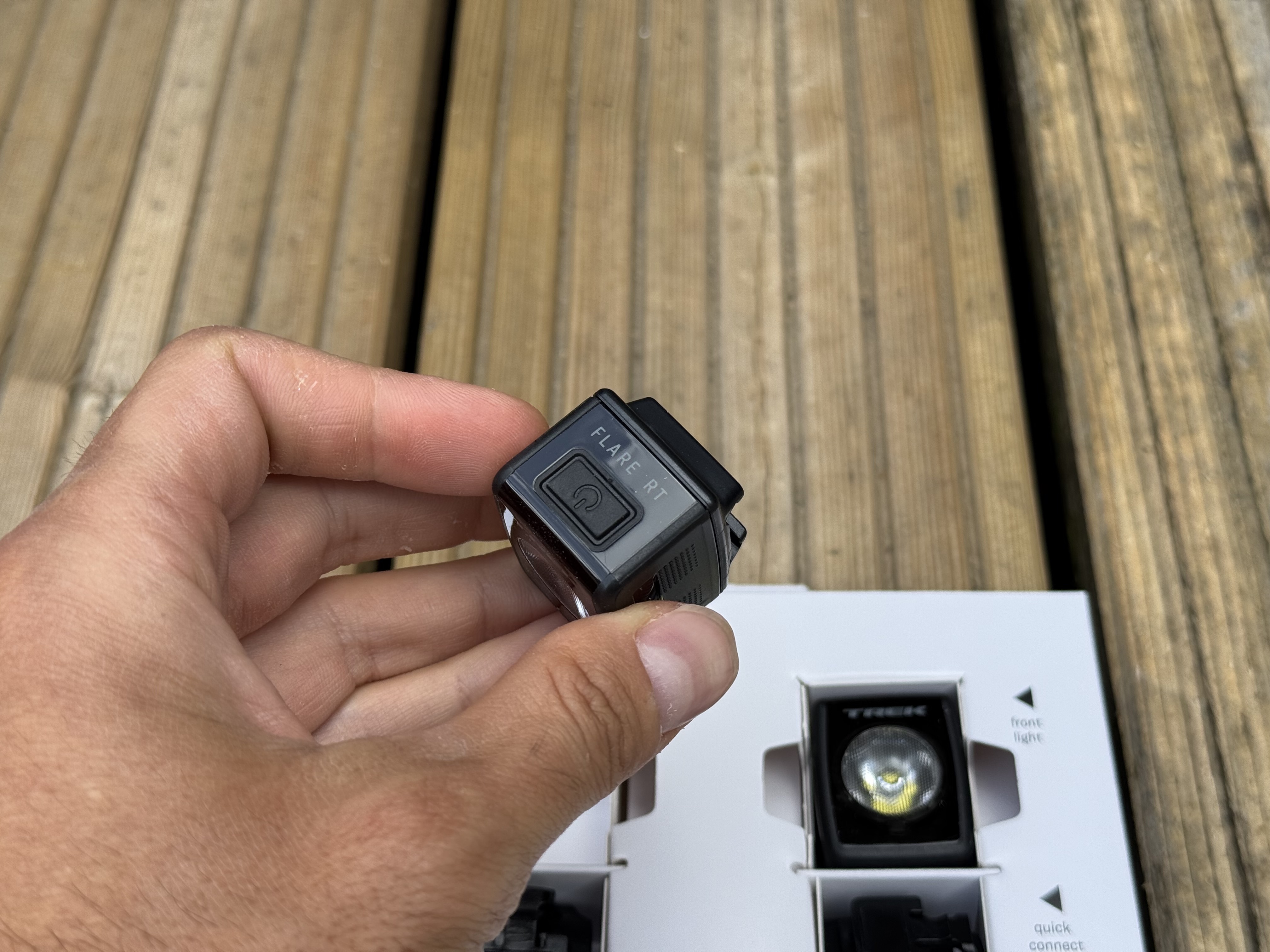
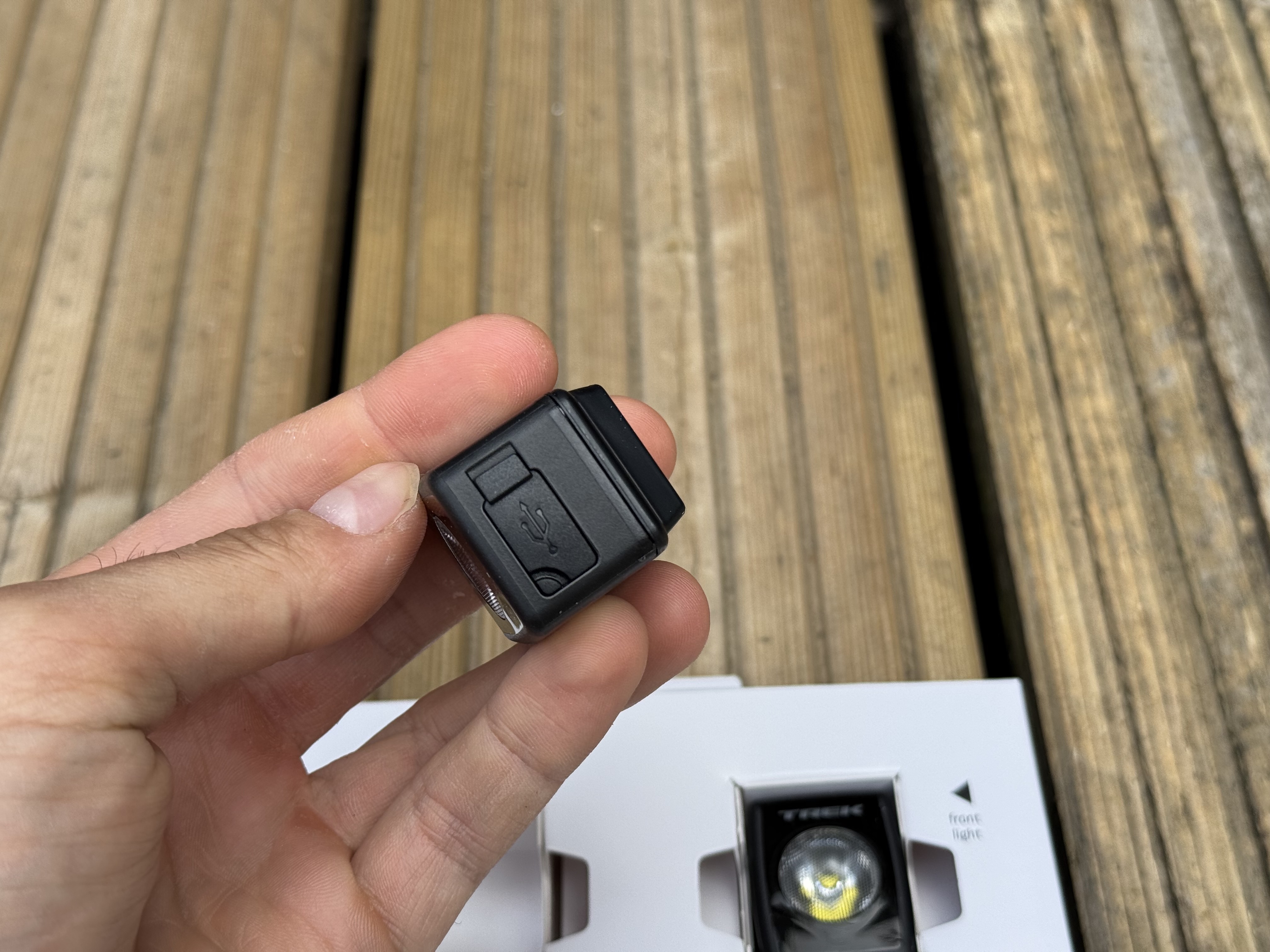

Design and specifications
Both the Ion 200 RT and Flare RT lights have a near identical body and design to each other. The only difference is one features red LEDs while the other uses white. Both attach with the same slide and click design onto the mount, while the rear attaches to vertical tubes like seat posts, the front attaches to horizontal tube shapes such as handlebars.
The mounts themselves use the same ladder rung with two clips as the Trek CarBack Radar and have three mounting points for adjustability based on tube diameter. Given that handlebars with bar tape tend to be a bit wider than round tubed seat posts, the mount is a touch longer. The rear mount has an angled tilt so account for seatpost angle. These lights are also compatible with Trek’s proprietary fitting system called Blendr, similar to Specialized’s SWAT. Trek/Bontrager saddles, helmets, and stems that feature Blendr can have the lights directly attached to them, saving the need for the ladder mount.
Both lights feature Micro USB charging, rather than the industry standard now of USB-C. This is a shame given the likes of the Trek CarBack use USB-C and the port size is not much wider. The port is covered by a rubber flap which gives an IPX7 waterproof rating.
Both lights claim to be visible in daylight up to 2km away, with the rear light being a maximum of 90 lumens, while the front offers 200. For the front light, Trek states that it uses special CREE LEDs. CREE is a specific brand and type of chip used in LED lights known for long lifespan and high brightness even with incredibly small and compact LED squares.
The latest race content, interviews, features, reviews and expert buying guides, direct to your inbox!
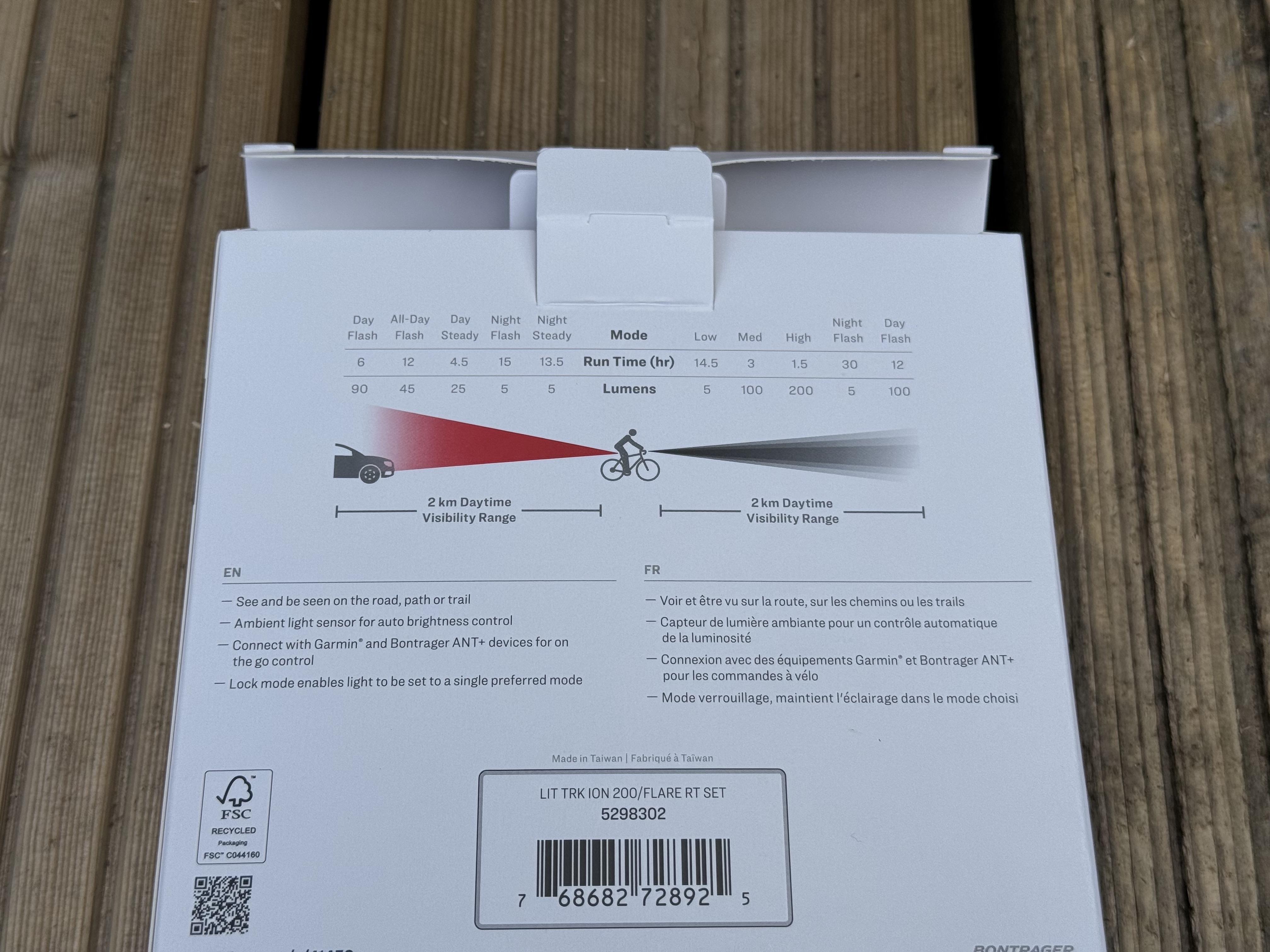
What is particularly clever about these lights is the inclusion of an integrated light sensor which auto-adjusts the brightness levels to match the ambient conditions. This has to be manually turned on for the lights, but will then alter the mode based on the conditions.
For the front light the five modes include three solid modes with 200, 100 and 15 lumen options, and a night and day flash mode. Battery life varies from 1.5hrs up to 30hrs claimed. Meanwhile the rear features three flash modes of 90, 45 and 5 lumens, and two steady modes of 25 and 5 lumens with battery ranging from 4.5 to 15hrs. A battery-save mode is also present where the light has 30 minutes of runtime once 5% battery life is hit.
Performance
First and foremost, these are very easy lights to set up, as long as you have round bars and seatpost. Although the mounts look very similar, the rear light mount features a small seatpost and saddle diagram so you know which orientation to fit it so that it is angled correctly. Both the front and rear use the same sort of ladder mount system, and if you have standard round tubes on the attachment points, it’s nice and easy.
However, using these on a bike with an aero tubed seatpost and integrated aero one-piece bar and stem, the mounts simply do not fit very well. With the rear light it was a struggle to get the mount to fit, while at the front there was the same issue and the light did not want to sit facing forwards. It either angled up or down with the thin profiled aero bars. A better mounting system is something like the ladder mount used on the Lezyne Strip Drive Pro 400+ as different sized ladders can be interchanged for particularly wide circumference tubes. Alternatively, if you have Trek Blendr accessories on your bike, then mounting is significantly easier. I particularly like the saddle mounting options as a saddle bag can still be mounted underneath using the rails.
As for the lights themselves though, for relatively low lumen levels they are impressively bright and aid visibility massively. These are a great set of daytime lights for drawing attention to riders and hopefully reducing the incidences of people driving cars not spotting you. The front in particular offers a very bright flash. There is very little side visibility of the lights but given where the front is mounted it won’t have much splash visibility due to the hoods and levers. The different modes also give a nice array of differing brightnesses for battery preservation.
Personally though I tended to keep them on the brightest settings. On the rear light, this yields about 4.5 hours maximum burn time, around the claimed life span in summer temperatures. Meanwhile the front light does last perhaps a touch less than the claimed 1.5 hours on max brightness. What this does mean is that these lights really are not suited for dark conditions riding, as 200 lumens is not enough to illuminate the road in any meaningful way at speed. But for city riding where roads are illuminated, these lights offer a brilliant accessory for enhancing rider visibility.
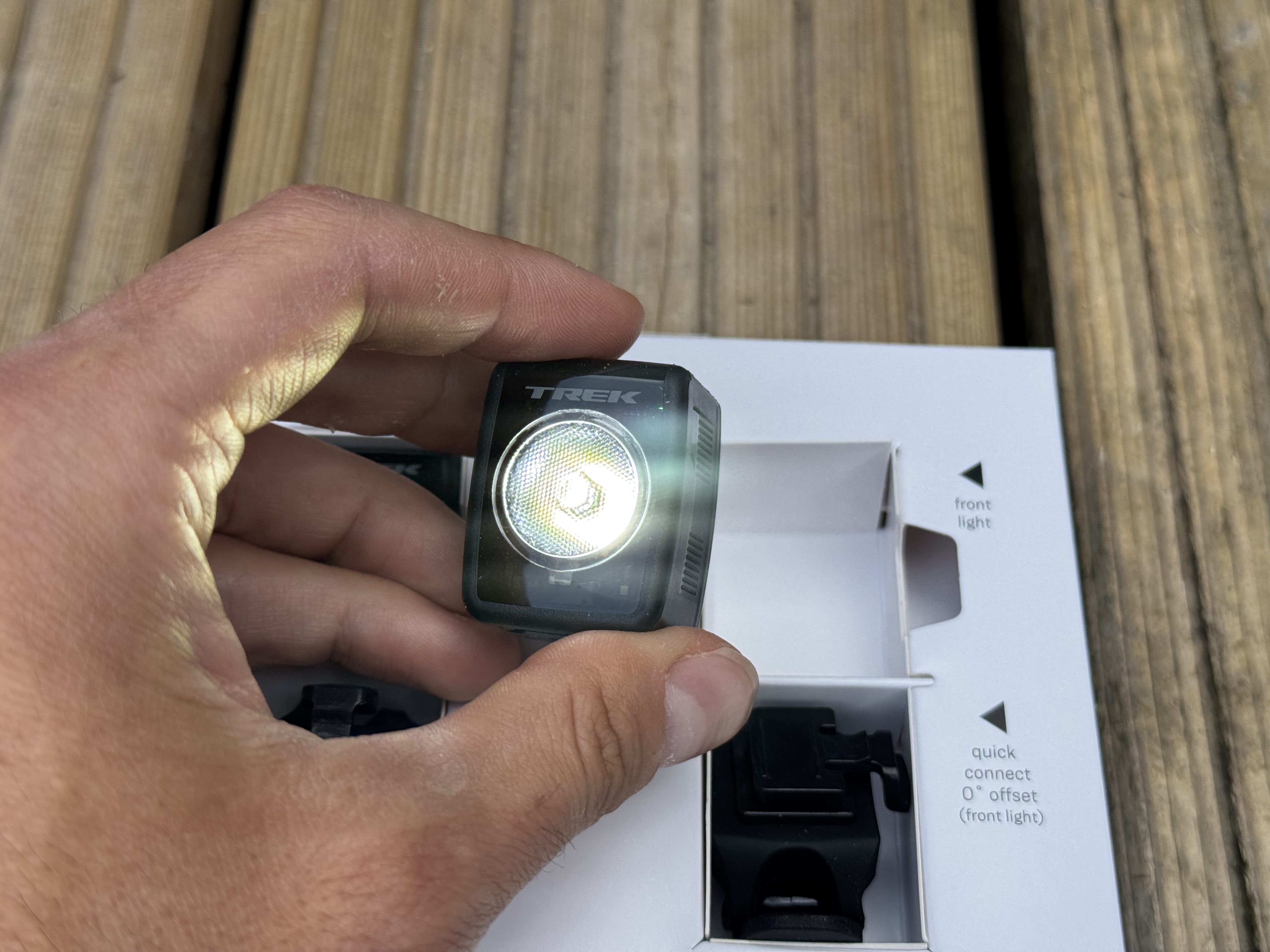
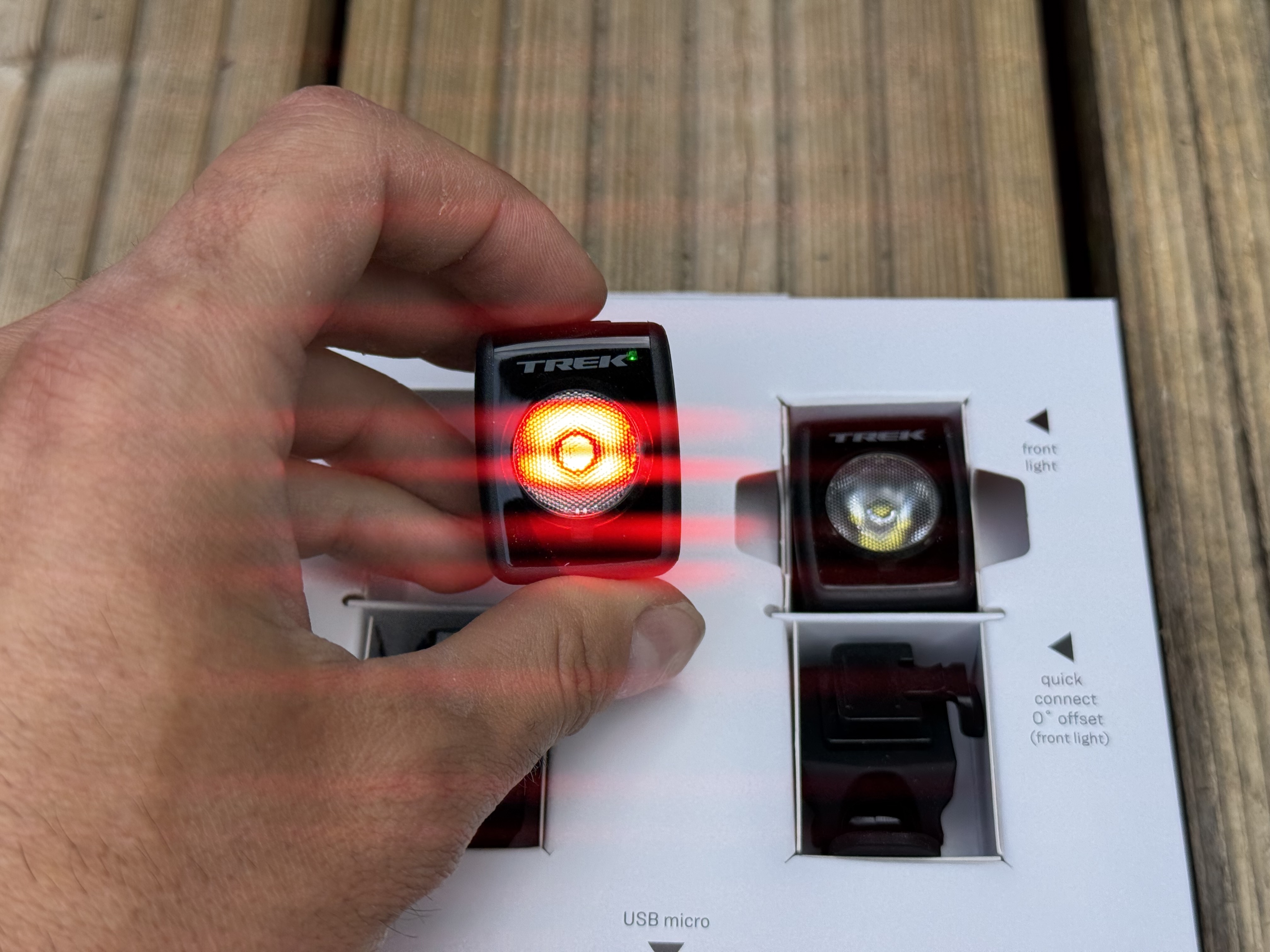
A quick note on the ambient light sensor as well. As standard this is always on, and has to be manually switched off. However, Trek states that modes can still be selected manually. I’ve not personally found much of an impact with the ambient lighting systems, certainly not for road riding. Perhaps I need to ride though some dark tunnels, but if they are properly dark then ideally a brighter light is required anyway, but conversely as they are just 'be seen' lights then you need fewer lumens when it's dark to stand out against the background light.
The battery life on the more powerful modes is also not really long enough to be usable over the course of evening sun down to pure twilight conditions. It’s a clever feature for sure, especially in such a small and compact package, but in testing I’ve not personally found a huge amount of use for it.
More practical is that the lights are controlled simply by one single button on the top. Single press tuns the light on, while holding the button for a couple of seconds turns it off. Single press switches mode, but there are also various extra settings activated by holding the button from 3 to 8 seconds. A nice auto feature though is the 5% battery save mode. When this happens, the front and rear lights drop down to a reduced power which provides 30 minutes of battery life.
Charging of the lights is a slight mixed bag. On the one hand, the charge port is easy to access but secure and waterproof. Charging also does not take particularly long, just two hours for both the front and rear light, which for the output is about average. The issue is that as almost every other cycling accessory has switched to USB-C, including other Trek lights such as the CarBack radar, the Ion and Flare remain on micro USB. It’s a small frustration even with a cable supplied, since it means another cable to keep track of rather than a set of nice interchangeable USB-C charge cables.
In terms of checking battery life, that’s a slightly odd one. Trek states that for 99-100% battery life the battery indicator LED will be a solid green, this is more to check that the light is fully charged. Beyond that, a green flash indicates 75-99% battery, while red flash is 0-75% charge, oddly small range save for the three quarters of battery life that is signalled by one indicator.
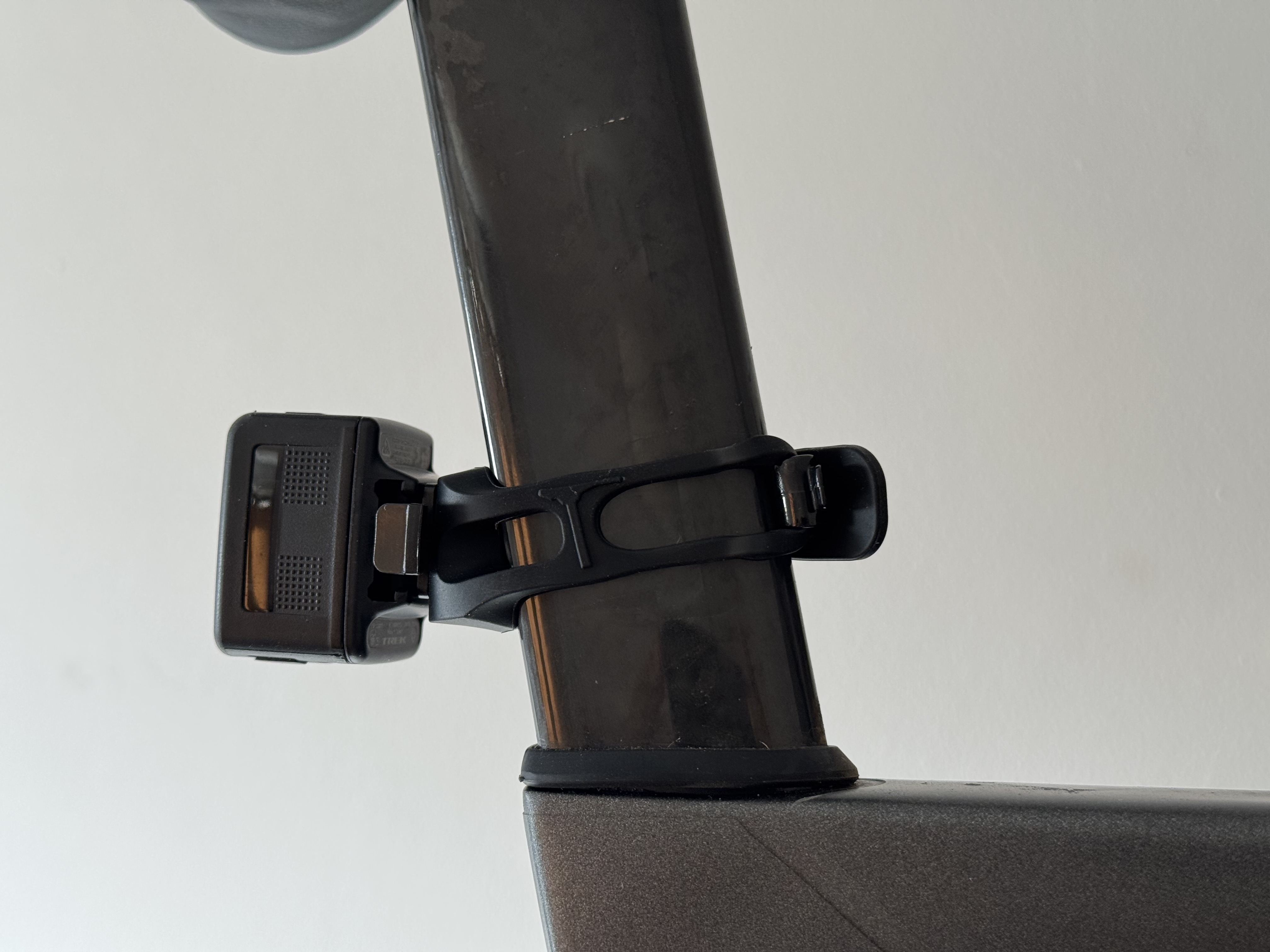

Value
This dual pack comes in at £89.99, slightly less than the individual retail of £49.99 for each light separately. Individually, there are certainly lights that I would argue offer better value. The aforementioned Lezyne Strip Drive Pro 400+ is arguably a better rear light, and only £55, but it is not as small and compact. Lights such as the Lezyne KTV Drive Pro+ are smaller and a touch more similar, but cost less at the expense of smart features.
For light bundles, a similar offering is the Specialized Stix Switch 2-Pack. These are very small and compact, and are far cheaper at £48 for the pair. They do though have limited features, lower lumens, limited modes, and awkward tube compatibility. Similar issues arise for the Giant Recon Hl 100 And Recon Tl 100 Combo Light Set, being lower powered and not as smart, but with a far similar design and about half the price.
There are of course some higher end options available, with the Knog Blinder Pro 1300 + R150 Rear - Light Set at £149.99, but these are substantially more powerful for £60 more money. The same can be said for the Macro Drive 1400+ and Strip Drive Pro 400+ LED Light Set for the same £150.
This does put the Trek Ion and Flare lights a little bit into their own category in the current market. Not quite as powerful as the £150 region offerings but generally smaller and compact. But also not as cheap as the £50 compact pairs that offer potentially better value overall, but are less powerful offerings without smart features.
If you want compact lights that have enough power to be truly visible during daylight riding, then the Trek Ion and Flare combo is perhaps a very sensible option to go for. Cheaper lights will not be as visible in daylight riding. However, the Trek lights are not powerful enough to double up as true nighttime lights, so for around £60 more you can get a set of lights that is powerful for true pitch black riding, while lower power modes make them more suitable for day time riding as well. But with a more powerful light comes more bulk, longer charge times, and often slightly less practical to mount on busy handlebars.
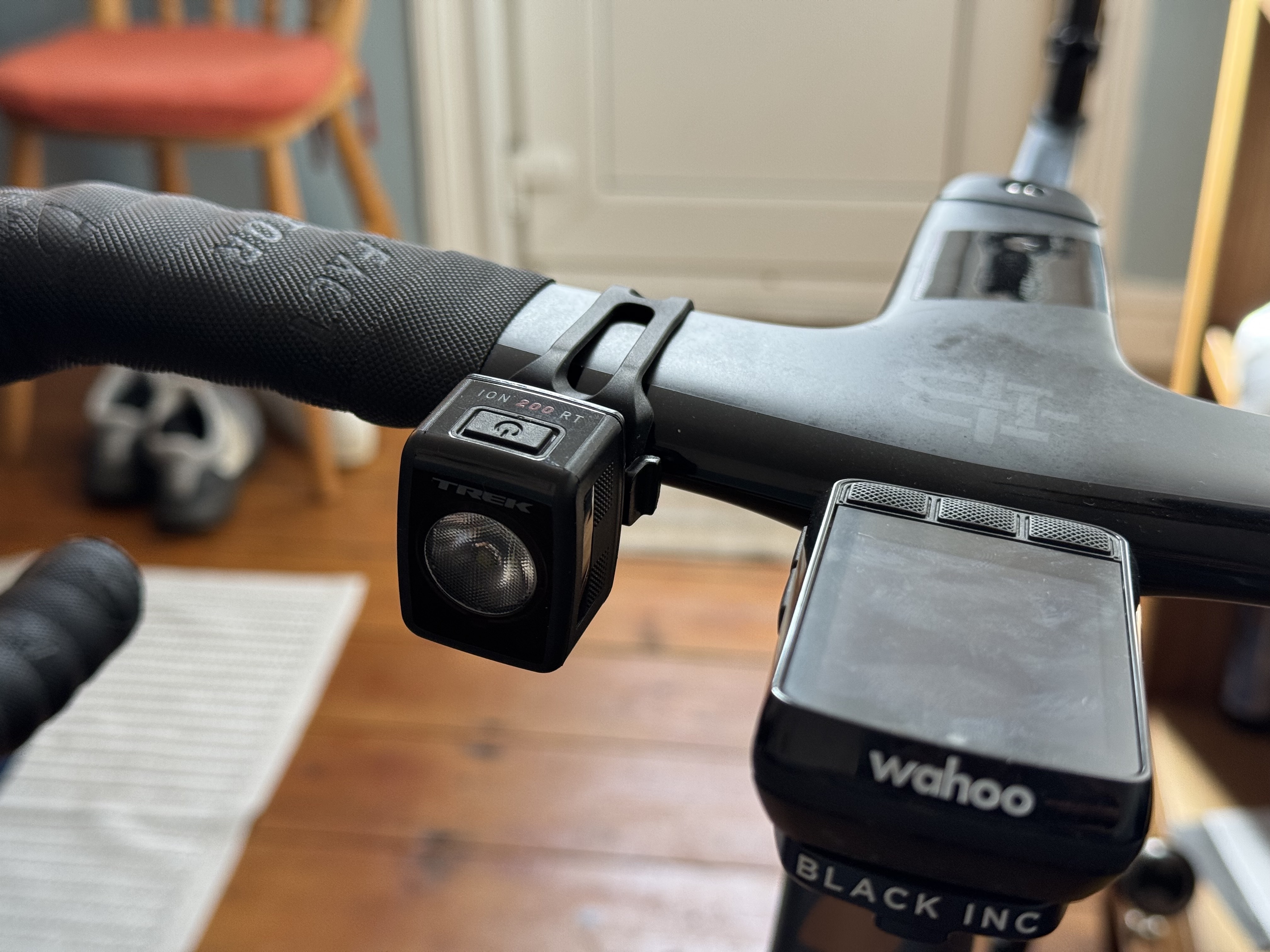

Verdict
The Trek Ion 200 RT and Flare RT light set are an incredibly competent sent of lights for enhancing visibility on the road. They aren’t the brightest so aren’t effective for illuminating a dark road, but for tiny company daytime lights they are possibly the most effective package that I have encountered.
A neat control system, ANT+ connectivity to computers and auto-brightness sensors are smart additions, but the light is not faultless. Lack of USB-C is for me frustrating and realistically the lights need an update for that. Battery life is strong on lower power modes, but drains fast on full brightness. Mounting is also great on round tubes, but struggles on wider aero tubes such a seatposts and handlebars. For a little more money you can also get a light set that although is larger, can be used as a daytime visibility light or a full night time illumination setup which I do think is worthwhile.
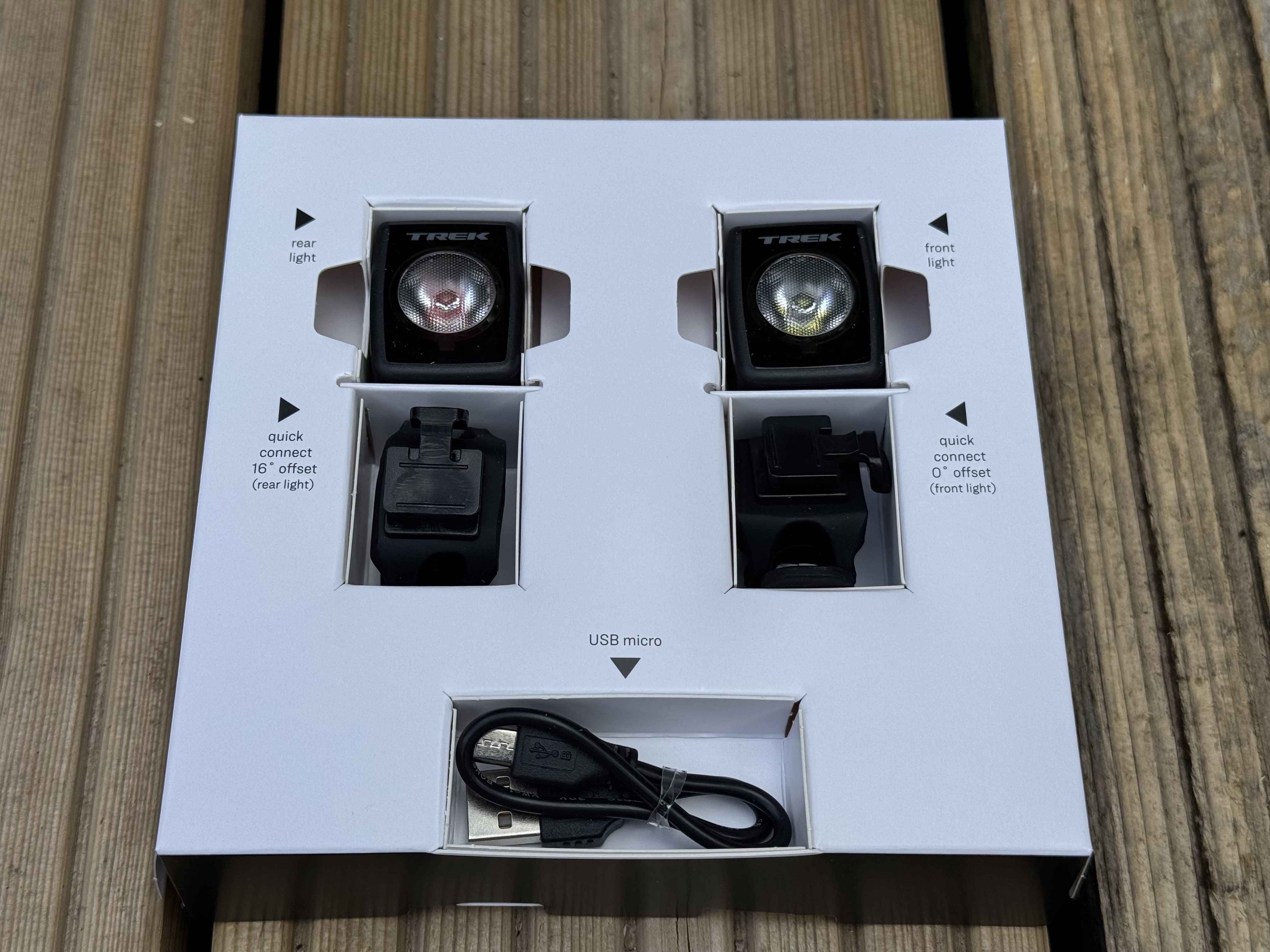
Attributes | Notes | Rating |
|---|---|---|
Design and aesthetics | I love the small and compact design which really punches above its weight for performance. However the mounts have been difficult to use outside of round tubes seatposts and handlebars, and Micro USB charging needs an update. | 7/10 |
Light quality | Frankly for this size the lights are bright and effective for being seen from a good distance away even in daylight. | 10/10 |
Control scheme | A single button controls all aspects of the light, or you can connect to a bike computer for added control. Some functions require a bit of reading to fully unlock, but it’s nothing difficult. | 9/10 |
Battery life and charging | Battery power on lower setting is superb, but brighter settings really drain the battery quite fast. However charging is done relatively quickly with these being such small lights. | 8/10 |
Value | These lights sit in their own little category or brighter than most budget light sets, but cheaper than more powerful options. If you want bright and compact, these are superb. If you want something more versatile, go for a more powerful combo set. | 8/10 |
Overall rating | Row 5 - Cell 1 | 84% |

Freelance cycling journalist Andy Turner is a fully qualified sports scientist, cycling coach at ATP Performance, and aerodynamics consultant at Venturi Dynamics. He also spent 3 years racing as a UCI Continental professional and held a British Cycling Elite Race Licence for 7 years. He now enjoys writing fitness and tech related articles, and putting cycling products through their paces for reviews. Predominantly road focussed, he is slowly venturing into the world of gravel too, as many ‘retired’ UCI riders do.
When it comes to cycling equipment, he looks for functionality, a little bit of bling, and ideally aero gains. Style and tradition are secondary, performance is key.
He has raced the Tour of Britain and Volta a Portugal, but nowadays spends his time on the other side of races in the convoy as a DS, coaching riders to race wins themselves, and limiting his riding to Strava hunting, big adventures, and café rides.
You must confirm your public display name before commenting
Please logout and then login again, you will then be prompted to enter your display name.

